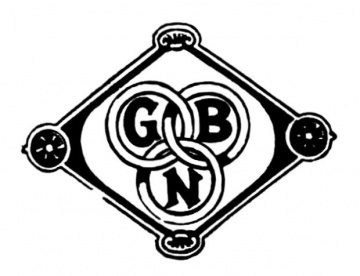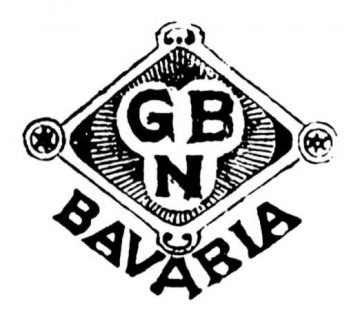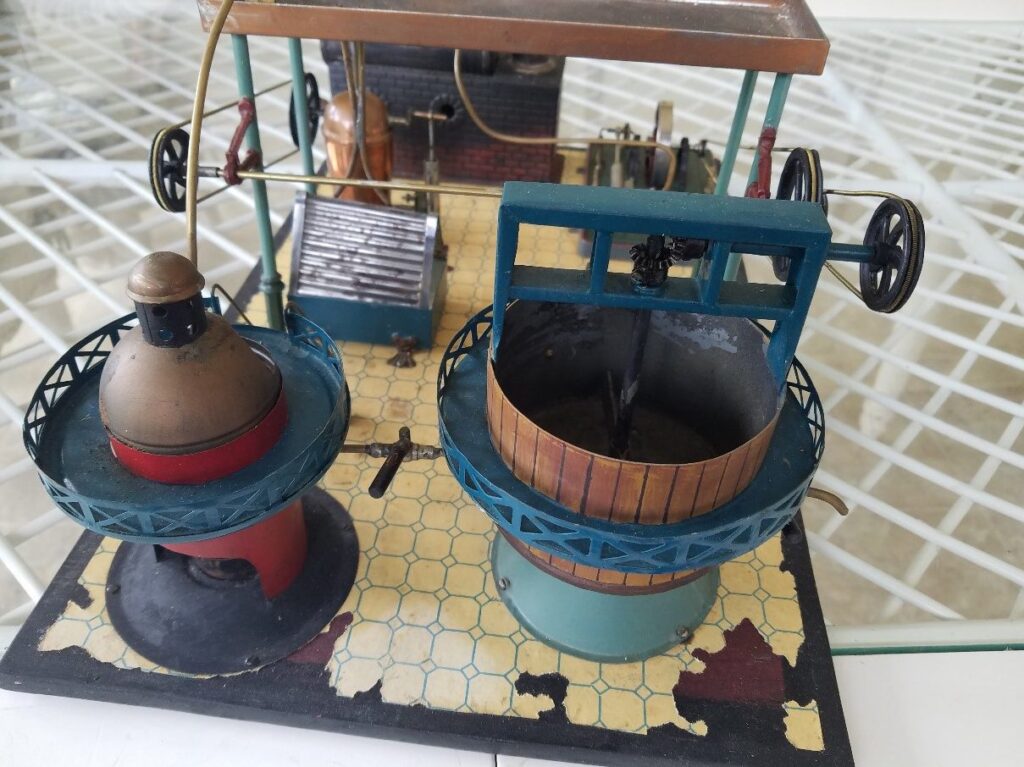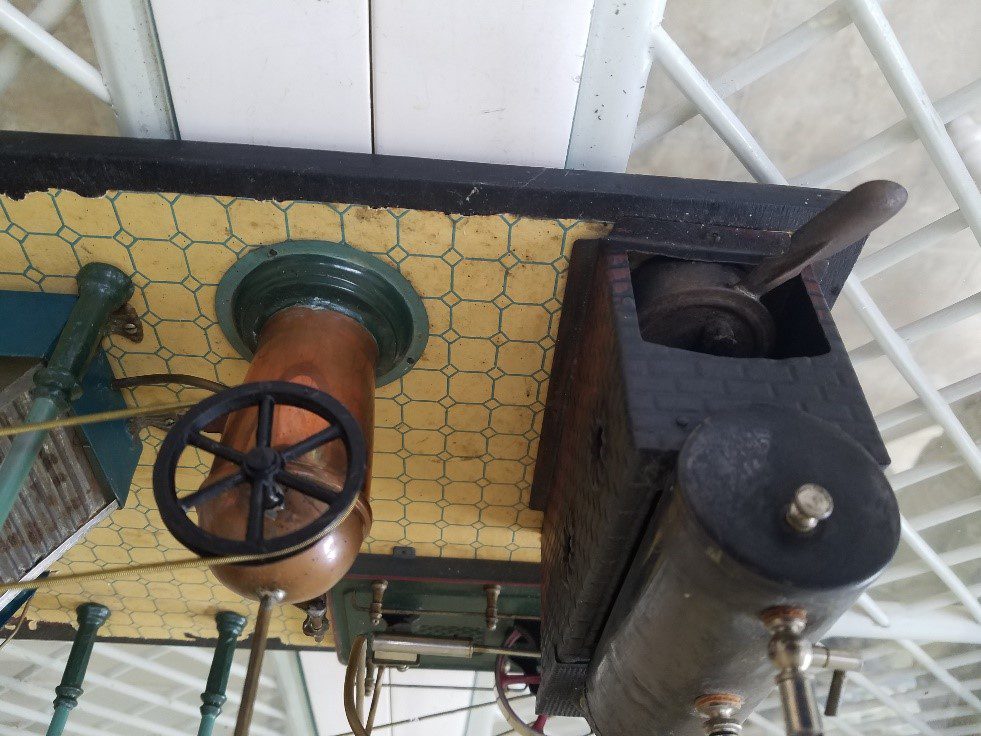Bing’s Working Live Steam Models
By Tyler Keck (NTTL Library Assistant) and Russ McFall (TCA 98-47746)
Bing trademarks (posted on the Western Division Manufacturer’s List)
During the late 19th and early 20th centuries, live steam models were a common sight on the toy landscape of Europe and North America. This was a result of the popularity of steam power, which inspired many toy companies to produce miniature steam engines. These working live steam models ranged from the intricate to the rudimentary in design and were often made out of tin during what became known as the “Golden Age” of tin toys (1890s to 1914). Among the many companies to manufacture working live steam models during this period were Bassett-Lowke, Bing, Carette, Ernst Plank and Märklin. These companies produced steam powered toys and offered a variety of different types including live steam locomotives, vertical steam engines, steam powered miniature carousels, and even steam powered miniature breweries. Even though numerous companies produced live steam models during the late 19th and early 20th centuries, this article will focus on one company, Bing, and how one collector’s story of discovery and persistence led him to acquiring one of Bing’s more unusual live steam models.
According to the book Collecting Toy Trains written by Pierce Carlson, some of the first early live steam locomotives appeared in Great Britain and Europe during the 1840s. These early live steam locomotives quickly earned the nicknames “dribblers” or “piddlers” because of the trail of water left behind from their steam cylinders. By the 1890s, manufacturers like Bing sold several “dribbler” models in various gauges. For instance, in the 1898 Bing Toy Catalogue, six different live steam locomotives were available for purchase including the No. 8373, which ran on 1 gauge track. Another live steam locomotive offered in the 1898 Bing Toy Catalogue was the No. 8381, which ran on what Bing called 4-gauge track. This 4-gauge track measured 72mm between the rails. According to the book Blechspielzeug Eisenbahn by Botho Wagner, as Bing grew into the largest toy company in the world by 1905, it expanded both its live steam locomotive offerings and its line of model steam engines.
By 1912, Bing had ten pages worth of live steam trains in its catalogue in four different gauges, which reflected the growing popularity of toy trains. These trains included the impressive No. 6359 L. & N.W.R. Express Steam Locomotive, which ran on 1 gauge track and featured an automatic reversing gear with a steam regulator that enabled users to start or stop the steam engine. Besides Bing’s expansion of its live steam locomotive line, the company also increased production of its line of live steam models. In 1898, Bing offered a variety of different live steam models spanning over ten pages. That number grew to well over 30 pages in 1912. This growth was not just confined to Bing’s line of live steam locomotives and working live steam models. Overall, the German company saw explosive growth in its line of toys during this same fourteen-year period. For example, the 1898 Bing Toy Catalogue offered 120 pages of toys and accessories. That number grew to over 400 pages by 1912.
One of Bing’s more striking toys in its 1906 and 1912 catalogues is the No. 14139 Brewery powered by steam. It measures 19.5 inches long, 9 inches wide and over 10.5 inches in height to the top of the stamped and japanned chimney.
The No. 14139 also included a fixed slide valve cylinder, an oxidized brass boiler, a safety valve, a steam whistle, a water gauge glass, a mash-charger, a mash-cooler, and a brewing-vat with copper fittings. The boiler of the steam engine measures 2 inches in diameter and is more than 4 inches in length. All of these features gave this working brewery model the ability to produce alcohol. The No. 14139 was not the only brewery model that Bing offered in its 1912 catalogue.
In 1912, Bing sold a slightly smaller less complex model brewery under its line of toys called Working Models of Domestic Machinery. This brewery, named the No. 9956 Fine Model Brewery, measured 14 inches long, 9 inches wide and 11 inches tall. It too was also sold in Bing’s 1906 catalogue, but unlike the company’s larger No. 14139 Brewery, the smaller No. 9956 was not powered by steam. Additionally, it did not feature an oxidized brass boiler. Besides being smaller and less equipped, the No. 9956 Fine Model Brewery also cost less than the larger No. 14130 steam powered Brewery, which made the No. 9956 more affordable.
Bing was not alone in manufacturing and selling realistic steam powered toys inspired by various industries. In the 1890s, Ernst Plank & Company introduced its No. 421A Live Steam Brewery to consumers, which measured over 13 inches long, 9 inches wide and 11 inches tall. Plank’s steam powered brewery came equipped with a three-legged steam engine and a water pump, which sent water throughout the model brewery giving it a sense of realism. While Plank’s live steam brewery was impressive by toy standards, it was Bing’s No. 14139 Brewery that caught the eye of collector Russ McFall. Here is Russ’s story.
While reading through the reproduction book of the 1906 Bing Toy Catalogue, I came across a page with two steam toys that caught my interest, Factory No. 13934 and Brewery No. 14139. At that moment, I decided to try to add these two working live steam models to my collection. I started searching eBay for the both of them, which turned out to be quite difficult. My month’s long search even led me to look through the German eBay site. Sometime passed before I found a seller in Australia, who was auctioning off Bing’s No. 14139 Brewery. I had never bought from a collector in Australia, which made me worry about shipping, tariffs, insurance, currency conversion and eBay’s guarantee.
After I first contacted the seller, several exchanges ensued which included discussions about my final bid, the cost of shipping and insurance. The 16 hour time difference between the east coast of the United States and Australia made negotiations a slow go. One of the last hurdles though was agreeing to a reasonable price for shipping. I conducted research online to see how much a similar item would cost to ship between Australia and the United States. At first, the seller quoted me shipping expenses that were three times the amount of money I estimated. With some more negotiations, we finally settled on a number. When it was all said in done, 39 days past before we reached a final agreement.
The next step was to select a shipper. After reviewing all the available options, the seller and I chose Australia Post International Standard, which quoted me 60 days for delivery. Surprisingly, the actual delivery time was only 20 days, which included a trip through customs at the currently backlogged Port of Los Angeles. To my relief, Bing’s No. 14139 Brewery arrived well packed and with no signs of damage. Despite the rollercoaster ride of emotions and the many challenges I encountered throughout the buying process, overall, I have to say my first time buying from a collector in Australia was a good experience. Now onto the next challenge, to find Bing’s No. 13934 Factory.










